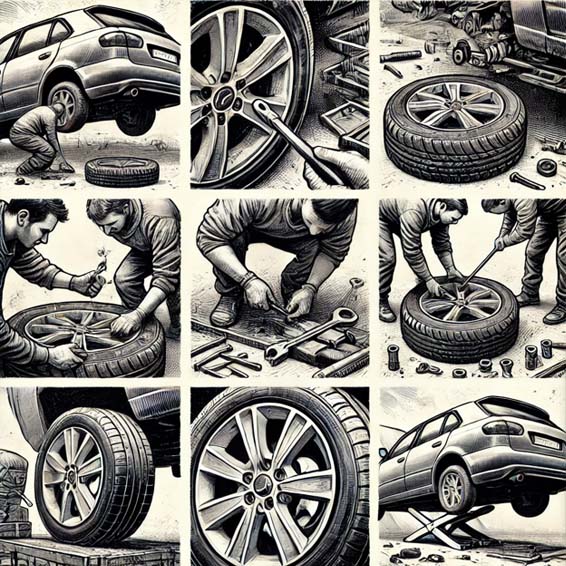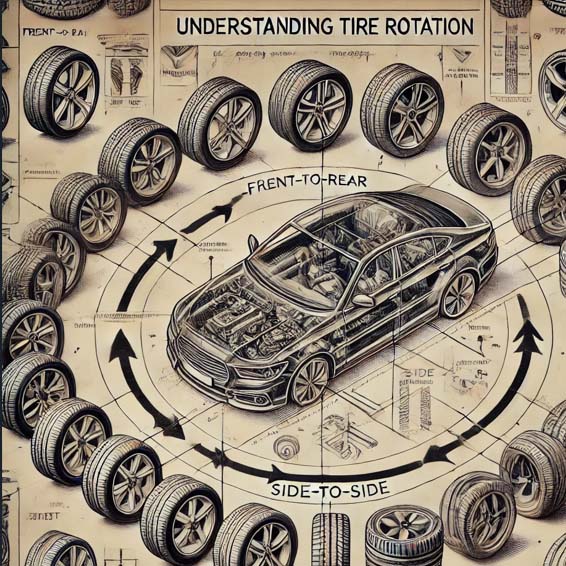Ensuring your car is safe and performing well hinges significantly on regular maintenance, and tire rotation is a key part of that. But how long does a tire rotation take? The answer varies, influenced by the type of vehicle, the method used, and the technician’s expertise. Knowing what to expect can make your service center visit smoother and keep your car in top shape.
How Long Does a Tire Rotation Take?
Rotating your tires is essential for even wear, longer tire life, and better performance. However, many drivers wonder about the time commitment. The answer isn’t cut and dry, as several factors come into play. In this guide, we’ll break down the tire rotation process, typical timeframes, influencing factors, and tips for efficient service.
Understanding Tire Rotation
Tire rotation means moving your tires from one position to another on the vehicle. It helps ensure they wear evenly, which is crucial for balance, handling, and safety. Usually, the rotation follows a pattern recommended by the vehicle manufacturer or a tire expert, such as front-to-back, side-to-side, or diagonal swaps.
Factors Influencing Tire Rotation Time
Several factors determine how long it takes to rotate your tires. Knowing these can help you plan your service better.
Type of Vehicle

The vehicle type affects the time needed. Compact cars often take less time compared to larger SUVs or trucks. The number of tires and the rotation complexity also play a role.
Technician’s Experience
An experienced technician can rotate tires more swiftly than a less seasoned one. Pros know the procedures and tools inside out, cutting down the time required.
Equipment and Tools

Modern, well-maintained tools and equipment make a big difference. A well-equipped service center can handle the task faster than one with outdated gear.
Additional Services
If you’re getting other services like balancing or alignment along with the rotation, it’ll take longer. Factor these in when estimating your visit duration.
Typical Tire Rotation Time
Generally, a tire rotation can take from 15 minutes to an hour. Here’s a closer look:
Quick Service at a Professional Shop
At a professional shop or dealership, expect the job to be done in about 15 to 30 minutes, thanks to their advanced equipment and experienced staff.
Adding Additional Services
Including wheel balancing or alignment? That’ll extend the time to around 45 minutes to an hour. These extras ensure your car runs smoothly but require more time.
DIY Tire Rotation
Are you doing it yourself? The time varies based on your experience and tools. An experienced DIYer might finish in an hour, while a novice might take longer.
Step-by-Step Guide to Tire Rotation

Understanding the steps can help you estimate the time needed:
Preparation
Gather tools:
- jack, jack stands, lug wrench, torque wrench, gloves.
- Park on a flat surface and engage the parking brake.
- Loosen lug nuts on all tires before lifting the vehicle.
Lifting the Vehicle
- Lift the vehicle one side at a time using a jack.
- Secure with jack stands for safety.
Removing and Rotating Tires
- Follow the recommended rotation pattern.
- Inspect tires for wear and damage.
Reinstalling Tires
- Reinstall tires in new positions.
- Hand-tighten lug nuts.
- Lowering the Vehicle and Final Tightening
- Lower the vehicle.
- Tighten lug nuts to specifications with a torque wrench.
Final Checks
- Ensure all lug nuts are secure.
- Check tire pressure and adjust if needed.
Benefits of Regular Tire Rotation

Regular tire rotation offers several perks:
Even Tire Wear
It Ensures longer tire life and better handling.
Improved Fuel Efficiency
Even wear reduces rolling resistance, boosting fuel efficiency.
Enhanced Safety
Proper traction and handling reduce accident risks.
Cost Savings
Extend tire life and save on replacements.
Tips for Efficient Tire Rotation
Here’s how to make the process quicker and smoother:
Schedule Regular Rotations
Follow manufacturer recommendations, usually every 5,000 to 7,500 miles.
Use Quality Tools
Invest in good tools for a smoother process.
Inspect Tires During Rotation
Check for damage or uneven wear and address issues promptly.
Combine Services
Pair tire rotation with other maintenance tasks to save time.
FAQ
How often should I rotate my tires?
Every 5,000 to 7,500 miles, per manufacturer guidelines.
Can I rotate my tires myself?
Yes, with the right tools and knowledge. Professionals, though, are quicker.
Does tire rotation affect alignment?
No, but get an alignment check if you notice issues.
What happens if I don’t rotate my tires?
Expect uneven wear, reduced lifespan, poor handling, and lower fuel efficiency.
Can I rotate my tires front to back?
Yes, but check your vehicle’s manual for the best pattern.
Do all vehicles require tire rotation?
Yes, for even wear and optimal performance.
Conclusion
Regular tire rotation is key for your vehicle’s performance, safety, and longevity. The time required varies, but understanding the process helps you plan better. Whether you DIY or visit a pro, regular rotation is a must. Follow your manufacturer’s recommendations and keep an eye on tire conditions for a smooth and safe ride.

